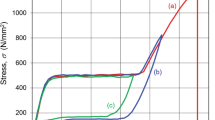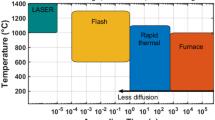Abstract
Shape memory alloys, particularly in the form of thin wires, are becoming increasingly attractive in the industrial field for the construction of compact actuators with high-power density. The structural and functional fatigue behavior of shape memory alloys undergoing thermomechanical cycling has been investigated only partially in the technical literature. In particular, the effects of operating parameters like the degree of martensite-austenite transformation and the heating rate on the fatigue life of the alloy have received very little attention so far. This paper explores the effect of these two parameters on the fatigue response of commercial SMA wires exposed to two linear stress-strain profiles during cycling. The results show the beneficial effects of partial transformation on the structural and functional life of the wires, with negligible loss of performance in terms of useful stroke. Though less markedly, the heating rate also has an effect on the structural and functional response, with the sine waveform supply performing better than the square profile.









Similar content being viewed by others
Abbreviations
- A f :
-
Austenite finish temperature
- A s :
-
Austenite start temperature
- F :
-
Frequency of the current waveform
- f L , f H :
-
Values of f at low and high pre-stress, respectively
- i :
-
Supply current
- i max :
-
Peak supply current
- i maxL , i maxH :
-
Values of i max at high and low pre-stress, respectively
- M f :
-
Martensite finish temperature
- M s :
-
Martensite start temperature
- N f :
-
Number of cycles to failure of the wire
- t ON :
-
Time at which the supply current equals i max
- t :
-
Time
- t p :
-
Period of the current waveform
- T :
-
Temperature
- T 1 :
-
Temperature of the wire when σ = σ p
- T max :
-
Maximum temperature achieved during heating of the wire
- w f :
-
Variable associated to the waveform of the supply current
- x :
-
Position of the moving end of the wire
- x lim :
-
Position of the moving end when in contact with the hard stop
- x min 0 :
-
Position of the moving end for the fully transformed wire in the first cycle
- x t :
-
Target value of x
- S 0 :
-
Stroke generated by the wire in the first cycle of the test
- δ:
-
Duty cycle
- Δε:
-
Shape memory effect (SME = εmax − ε min)
- ε:
-
Tensile strain in the wire
- εlim :
-
Maximum strain allowed in the wire during test
- εmin :
-
Minimum wire strain recorded in the cycle
- εmax :
-
Maximum wire strain recorded in the cycle
- εmin0 :
-
Strain in the austenitic wire after shape recovery in the first cycle of the test
- ξ:
-
Any of the variables σ p, φ, w f
- ξ coded :
-
Coded form of variable ξ
- ξ low, ξ high :
-
Higher and lower values, respectively, of variable ξ
- σ:
-
Tensile stress in the wire
- σmax :
-
Maximum wire stress recorded in the generic cycle
- σ p :
-
Pre-stress in the wire
- φ:
-
Ratio of recovered strain
References
G. Eggeler, E. Hornbogen, A. Yawny, A. Heckmann, and M. Wagner, Structural and Functional Fatigue of NiTi Shape Memory Alloys, Mater. Sci. Eng. A, 2004, 378, p 24–33
E. Hornbogen, Review Thermo-Mechanical Fatigue of Shape Memory Alloys, J. Mater. Sci., 2004, 39, p 385–399
V. Demer, V. Brailovski, S.D. Prokoshkinb, and K.E. Inaekyana, Thermomechanical Fatigue of Nanostructured Ti-Ni Shape Memory Alloys, Mater. Sci. Eng. A, 2009, 513–514, p 185–196
O.W. Bertacchini, D.C. Lagoudas, and E. Patoor, Thermomechanical Transformation Fatigue of TiNiCu SMA Actuators Under A Corrosive Environment—Part I: Experimental Results, Int. J. Fatigue, 2009, 31, p 1571–1578
D.C. Lagoudas, D.A. Miller, L. Rong, and P.K. Kumar, Thermomechanical Fatigue of Shape Memory Alloys, Smart Mater. Struct., 2009, 18, p 085021 (12 pp)
A. Paradis, P. Terriault, and V. Brailovski, Modeling of Residual Strain Accumulation of NiTi Shape Memory Alloys Under Uniaxial Cyclic Loading, Comput. Mater. Sci., 2009, 47, p 373–383
C. Dunand-Châtellet and Z. Moumni, Experimental Analysis of the Fatigue of Shape Memory Alloys Through Power-Law Statistics, Int. J. Fatigue, 2012, 36, p 163–170
C. Calhoun, R. Wheeler, T. Baxevanis, and D.C. Lagoudas, Actuation Fatigue Life Prediction of Shape Memory Alloys Under the Constant-Stress Loading Condition, Scripta Mater., 2015, 95, p 58–61
K. Smith, P. Watson, and T. Topper, A Stress-Strain Function for Fatigue of Metals, J. Mater., 1970, 5, p 767–788
G. Scirè Mammano and E. Dragoni, Functional Fatigue of Ni-Ti Shape Memory Wires Under Various Loading Conditions, Int. J. Fatigue, 2014, 69, p 71–83
G. Scirè Mammano and E. Dragoni, Effect of Loading and Constraining Conditions on the Thermomechanical Fatigue Life of Niti Shape Memory Wires, J. Mater. Eng. Perform., 2014, 23, p 2403–2411
G. Scirè Mammano and E. Dragoni, Functional Fatigue of NiTi Shape Memory Wires under Assorted Loading Conditions. Advances in Science and Technology 78 (P. Vincenzini, S. Besseghini, S. Miyazaki, E. Quandt, M. Taya, Ed.): 40–45, 2013. (Proceedings of CIMTEC 2012—4th International Conference on Smart Materials, Structures and Systems. June 10-14, 2012, Montecatini Terme, Italy.)
L. Fumagalli, F. Butera, and A. Coda, SmartFlex NiTi Wires for Shape Memory Actuators, J. Mater. Eng. Perform., 2009, 18, p 691–696
R. Hangekar and S. Seelecke, A multi-channel power controller for actuation and control of multiple SMA actuators. In: Proceedings of the ASME Conference on Smart Materials, Adaptive Structures and Intelligent Systems 2009 (SMASIS 2009), Oxnard, CA, 21–23 September, Paper No. SMASIS2009-1437, 2009, p 383–391
N. Ma and G. Song, Control of Shape Memory Alloy Actuator Using Pulse Width Modulation, Smart Mater. Struct., 2003, 12, p 712–719
R. Casati, F. Passaretti, and A. Tuissi, Effect of Electrical Heating Conditions on Functional Fatigue of Thin NiTi Wire for Shape Memory Actuators, Proc. Eng., 2011, 10, p 3423–3428
E. Borlandelli, D. Scarselli, A. Nespoli, D. Rigamonti, P. Bettini, M. Morandini, E. Villa, G. Sala, and M. Quadrio, Design and Experimental Characterization of a NiTi-Based, High Frequency, Centripetal Peristaltic Actuator. Smart Mater. Struct., 2015, 24 (doi:10.1088/0964-1726/24/3/035008).
D.C. Montgomery, Design and Analysis of Experiments, Wiley, New York, 2008
T. Georges, V. Brailovski, and P. Terriault, Experimental Bench for Shape Memory Alloys Actuators Design and Testing, Exp. Tech., 2011, 37, p 24–33
Acknowledgments
This research received no Grant from any funding agency in the public, commercial, or not-for-profit sectors.
Author information
Authors and Affiliations
Corresponding author
Rights and permissions
About this article
Cite this article
Scirè Mammano, G., Dragoni, E. Effect of Stress, Heating Rate, and Degree of Transformation on the Functional Fatigue of Ni-Ti Shape Memory Wires. J. of Materi Eng and Perform 24, 2709–2719 (2015). https://doi.org/10.1007/s11665-015-1561-7
Received:
Revised:
Published:
Issue Date:
DOI: https://doi.org/10.1007/s11665-015-1561-7




